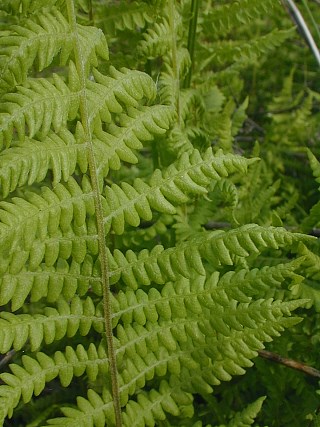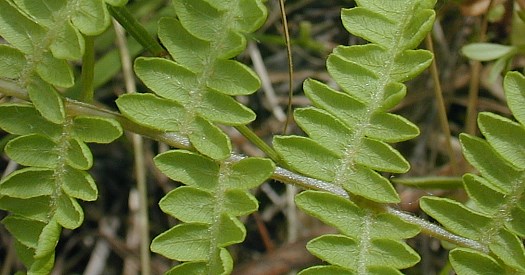Description: This perennial fern has erect to ascending compound leaves about 1–2½' tall and 4-7" across. Fertile leaves tend to be a little smaller in size than infertile leaves; they are both deciduous and die down during the winter. The compound leaves are pinnate-pinnatifid in structure and lanceolate to lanceolate-oblong in outline; their petioles are pale tan or pale purplish tan and mostly glabrous. The blade tissue of these leaves is light green and hairless on both the upper and lower sides. In contrast, the central stalk (rachis) of the compound leaf and the lateral stalks (rachillae) of the pinnatifid leaflets are finely pubescent on their lower sides. Each compound leaf has 10-40 pairs of leaflets; these leaflets are deeply pinnatifid and narrowly lanceolate-oblong. Often, a compound leaf and its leaflets are slightly curved and twisted. The lobes of the leaflets are oblong or oblong-lanceolate in shape, while their margins are smooth and strongly involute (curved downward). The lobes are spaced close together along the length of each leaflet. On the lower surface of each lobe, there is a central vein with several lateral veins. Each lateral vein becomes forked and divides into two veins.

On fertile leaves, round sori
(spore-bearing structures) are located above the forks of each lobe.
Immature sori are covered by an indusium (protective membrane) that
eventually withers away. The spores are produced and released during
the summer or fall. The root system is rhizomatous and fibrous. Dense
colonies of compound leaves are often produced from the spreading
rhizomes.
Cultivation:
The preference is full sun to light shade, wet to moist conditions, and
a sandy acid soil. However, this fern readily adapts to other kinds of
soil. It doesn't like too much standing water or excessive shade.
Foliar disease and insect pests are rarely troublesome.
Range & Habitat:
The native Marsh Fern is occasional to locally common in the northern
half of
Illinois, while in the southern half of the state it is rare or absent
(see Distribution
Map). The typical variety of this fern is found in Eurasia.
Habitats include damp sandy thickets, damp sandy meadows, swamps, fens,
edges of marshes and bogs, springs and gravelly seeps, and roadside
ditches. As the common name suggests, this fern is usually found in
sunny wetland areas.
Faunal Associations:
The caterpillars of Fagitana littera (Marsh Fern
Moth) feed on the leaves of this fern. The Marsh Fern is the only known
host plant of this uncommon moth. Because this fern often forms dense
colonies of leaves, it provides good cover for the smaller kinds of
wildlife.

Photographic
Location:
Edge of a sandy marsh in Vermilion County, Illinois.
Comments: This
is an attractive medium-sized fern with light green leaves. It is
unusual among ferns because of its preference for sunny habitats. To
identify this species, look for the strongly involute margins of the
lobes and the forked lateral veins on their undersides. While it is not
immediately obvious, the undersides of the central stalks (rachis) and
lateral stalks (rachillae) are finely pubescent, rather than glabrous,
for the North American ecotype of this fern. A similar species, Thelypteris
noveboracensis (New York Fern), which is uncommon in
Illinois, has lower leaflets that are substantially reduced in size.
The lower leaflets of the Marsh Fern, in contrast, are only slightly
reduced in size. Some authorities assign this fern to the Polypodiaceae
(True Fern family); Dryopteris thelypteris is
another scientific name for this species.